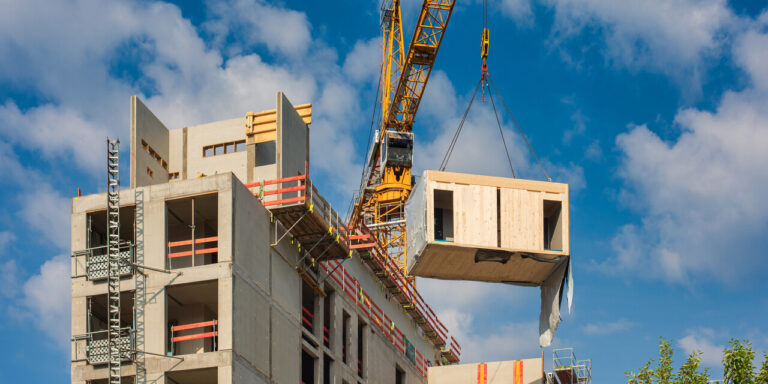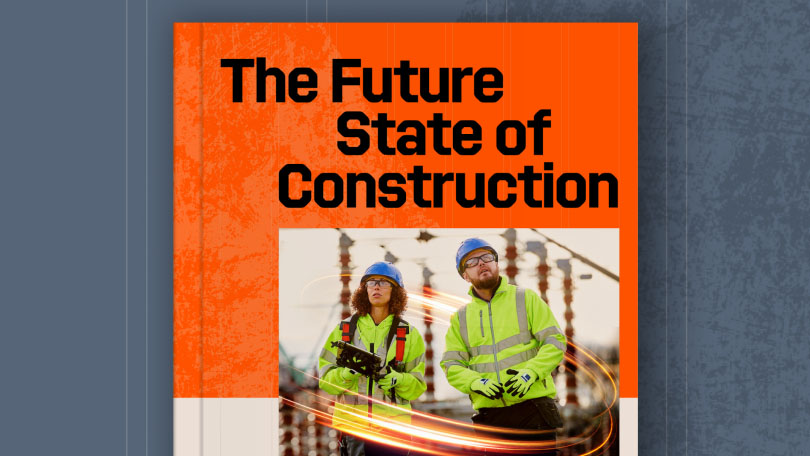— 11 min read
What is MMC?

Last Updated Aug 28, 2025

Daniel Kavanagh
Solution Specialist, Industry Compliance
15 articles
Daniel Kavanagh is a Senior Strategic Product Consultant at Procore, based in Dublin, Ireland. Daniel is a results-oriented project manager with a passion for building relationships and exceeding client and management expectations, with career experience in project management, systems implementation, technical design and architectural finishes. Daniel has been a member of the construction industry since 2014, and graduated from the Carlow Institute of technology.

Nicholas Dunbar
Content Manager
62 articles
Nick Dunbar oversees the creation and management of UK and Ireland educational content at Procore. Previously, he worked as a sustainability writer at the Building Research Establishment and served as a sustainability consultant within the built environment sector. Nick holds degrees in industrial sustainability and environmental sciences and lives in Camden, London.
Last Updated Aug 28, 2025

Modern methods of construction (MMC) are construction’s new solutions to age-old problems. By embracing technology, innovation and new ways of working, MMC represent brand-new benefits and opportunities for the construction sector.
Table of contents
Definition of MMC
Modern methods of Construction (MMC) are new ways of building that emphasise off-site manufacturing, standardisation, and automation to enhance efficiency, quality, and productivity. By prefabricating components in controlled environments, MMC reduces on-site labor, minimises waste, and ensures consistent quality, transforming traditional construction practices.
Key Aspects of MMC
The following list of modern methods of construction is just a handful of the methods available to construction professionals. More methods arise as technology and innovative thinking continue to progress, but these are some of the types of MMC that we see active today.
Off-site Fabrication
Off-site fabrication is the process by which construction teams assemble or manufacture parts for a project away from the building site. This generally takes place in large warehouses or factory environments. There are many benefits to this process, including needing fewer people on site, which creates a safer environment, and time savings thanks to the ability to work on multiple processes in parallel. Off-site fabrication requires proactive project and logistics management to make sure that all deliveries are properly scheduled.
Prefabrication
The development of off-site fabrication has paved the way for modular building, which is a technique that enables construction teams to build a prefabricated structure in sections called ‘modules’, that can then be fitted together once on site.
Modular construction, particularly in residential sectors, offers massive opportunities. It allows for buildings to be prefabricated in parts and assembled on site, significantly speeding up construction and improving quality thanks to the factory conditions.

Daniel Kavanagh
Solution Specialist, Industry Compliance
Procore Technologies
With this method, houses can be built, for example, in two separate pieces then fitted together on site. Modular building is quicker than traditional building methods, with production line fabrication supporting consistency and high quality.
Precast panels
Precast panels are another factory-based innovation that help to speed up construction and reduce the amount of work done on site. They are concrete panels which are cast in a mould and cured, and can be used for walls and floors, among other components. Many companies are using precast panels to speed up construction timelines. Since they are made in a factory, their production is not impacted by adverse weather conditions.
Design for Manufacture and Assembly (DfMA)
DfMA is a design approach focused on simplifying both the manufacturing and assembly stages. It aims to improve efficiency and reduce costs by designing components that are easier to manufacture and assemble.
Automation
Automation in construction refers to using advanced technology and machinery to perform tasks with minimal human input. This enhances precision and boosts efficiency across various construction processes.
Standardisation
Standardisation ensures that uniform procedures and specifications are followed throughout the construction process. This results in consistent quality and improved efficiency during production and assembly. For example, the Hinkley Point C nuclear power station project in the UK uses standardised components across its construction significantly reducing construction errors and delays.
Digitial Delivery & Building Information Modelling (BIM)
Digital delivery, particularly through Building Information Modelling (BIM) allows you to create a 3D model of a construction project collaboratively, as well as integrating data such as project schedules, budget information, project management, and more. It essentially acts as a shared platform which allows construction professionals to work together on an up-to-date digital twin of a build in real time. You can learn more in our article about BIM.
Hybrid Methods
These methods blend traditional construction techniques with modern innovations to optimise resources and improve overall project outcomes.
Learn about the future of the built environment - Read Procore's Future State of Construction report
Learn how contractors, subcontractors, and project teams can take advantage of new opportunities to boost efficiency and profitability over the next decade. Download the report to get your roadmap to the future state of construction.

Benefits of Modern Methods of Construction
MMC usher in a whole host of benefits for construction professionals and clients, which makes them attractive for both sides of the construction project equation. Here are some of the key benefits that they unlock:
Improved efficiency and speed
Most of the MMC we have discussed in this article involve fabricating elements in a factory or warehouse setting instead of on the building site. This brings with it the benefits of a production line-style of working, which is faster than building on site. There are fewer, if any, distractions or delays caused by unforeseen site conditions, as the environment is controlled and purpose-built. Many MMCs also speed up site construction work, too, as components arrive prefabricated and need less set-up time. Ultimately, this leads to a much faster project delivery than traditional methods of construction.
Using MMC, combined with just-in-time deliveries, dramatically enhances project efficiency. This method requires meticulous planning but offers massive benefits, allowing projects to proceed faster by resolving potential on-site construction clashes beforehand.

Daniel Kavanagh
Solution Specialist, Industry Compliance
Procore Technologies
Improved quality and consistency
The factory environment, in which many MMC processes take place, also benefits quality and consistency. It reduces the likelihood of accidents or negative effects of bad weather. The precision engineering and advanced technology, such as automation used to construct components, enables a level of standardisation that is not easy to maintain with traditional methods. There is also extensive quality assurance that helps ensure that all components are up to standard before they leave the fabrication environment.
The quality assurance from MMC is unparalleled. Prefabrication in controlled factory settings ensures consistent high quality, free from the unpredictability of on-site construction.

Daniel Kavanagh
Solution Specialist, Industry Compliance
Procore Technologies
Sustainability benefits
Modern methods of construction are often more sustainable than traditional methods. MMC creates less waste because the precision of cutting and assembly mean that it’s easier to use the exact quantity of materials, with no need for generous allowances, to make sure sizing is correct. Often, there are more opportunities to reuse surplus materials and better recycling facilities in a factory or warehouse environment.
MMC also typically mean fewer deliveries are made to the site as all materials are kept in one place until the delivery of the larger completed component, rather than needing lots of separate trips to deliver materials when constructing a component on site.
Safety
A more people-focussed benefit of MMC is that many of the methods we have looked at help to create a safer environment on building sites. They reduce the number of people and volume of materials needed on site the due to the ability to manufacture components remotely. This in turn reduces the risk of accidents and injuries caused by too much foot traffic and storage issues.
Cost-effectiveness
With less reliance on having people on site, these methods also introduce financial advantages because on-site labour is often more expensive than off-site fabrication. MMC also allows project teams to work to shorter project timelines because of the ability to work on multiple phases of construction at the same time. Reduced waste also means reduced expenses, as it’s easier to pay for the exact amount of materials that you need with these methods — traditional methods often rely on generous estimates for allowances in case of mistakes, which is expensive.
Challenges and Barriers to MMC
Resistance to Change
The change from traditional methods to using MMC requires learning and upskilling, as any new development that leads to a change in ways of working does. Some people are more adaptable to change than others, so it’s important that there is strong leadership buy-in and enough education around the how and why of introducing MMC to your construction projects.
Initial Cost and Investment Requirements
MMC requires a level of investment before a company will see the return, which is common for a lot of transformation initiatives. However, balancing this with the potential to do work quicker and with less requirement for on-site labour should provide a reassuring evaluation of the potential returns that MMC can bring.
While MMC is often perceived as costly, a detailed return on investment analysis can reveal its economic advantages. These include reduced on-site accidents, lower rework needs due to improved quality, and the efficient use of resources, all contributing to cost savings over time.

Daniel Kavanagh
Solution Specialist, Industry Compliance
Procore Technologies
Lack of awareness
MMC are not yet mainstream and may require some intensive discussions to demonstrate the value of trying them. It can be difficult to go against general practice when mainstream methods of construction have been working well for a long time, so it’s important to show value to get people on board.
Low Uptake of MMC
The slow adoption of MMC can be attributed to several factors, including entrenched traditional business models and financing hurdles, especially within the housebuilding sector. Traditional practices are deeply rooted, and the transition to MMC requires a significant overhaul of established processes. Financing structures often do not align well with the upfront investments needed for MMC, creating additional barriers to entry.
Government Policy
Government strategies play a big role in the adoption of MMC. A lack of specific initiatives, targets, or funding can hinder progress. On the other hand, proactive government policies, such as grants and tax incentives, can accelerate MMC adoption. However, inconsistent regulatory frameworks and insufficient support for MMC-specific guidelines can slow down the industry's willingness to transition.
Skills and Workforce
The construction industry faces a growing skills gap and an aging workforce, which poses a challenge for the adoption of new MMC technologies and processes. Training and development programs are essential to equip the current workforce with the necessary skills to operate in an MMC-driven environment. Without such initiatives, the industry risks falling behind in implementing improvements.
Lack of Collaboration
Successful implementation of MMC requires improved collaboration among designers, manufacturers, and contractors. Traditional construction often operates in silos, but MMC demands a more integrated approach. Better communication and partnership across these sectors are necessary to streamline processes and maximise the benefits of MMC.
Traditional Financing Models
Current financing and cash flow models in construction typically do not support the upfront investments required for offsite manufacturing and MMC projects. These models are often designed around traditional, incremental build processes, which can delay or discourage investment in MMC. To overcome this, innovative financing solutions that align with the capital needs of MMC projects are necessary.
How can technology help to successfully adopt MMC?
Construction management can help to integrate MMC with current ways of working. It can help with the scheduling aspect of construction projects, as MMC that involve off-site fabrication need very careful logistics and project management to make sure that deliveries happen on time and at the right time. Here's a few examples:
- Building Information Modelling (BIM) for Design and Coordination: BIM is an essential technology for MMC, offering detailed 3D modeling and real-time data management to streamline the design and planning phases. By providing a comprehensive digital representation of a construction project, BIM facilitates collaboration among architects, engineers, and contractors. For example, in the construction of the Sydney Opera House's recent refurbishment, BIM was used to coordinate complex design elements, ensuring that all teams had access to up-to-date designs and schedules. This reduces errors and miscommunication, making the adoption of MMC more efficient and effective.
- Automation and Robotics in Off-site Manufacturing: Automation and robotics significantly enhance the efficiency and precision of off-site manufacturing processes. Factories equipped with robotic systems can produce construction components with high accuracy and reduced labor costs. For instance, the use of robotics in the assembly of prefabricated modules at the Balfour Beatty manufacturing plant allows for faster production and higher quality standards. These automated processes are crucial in meeting the demands of MMC by reducing on-site construction time and improving overall project efficiency.
- Digital Project Management Tools: Digital project management tools play a critical role in coordinating and managing construction projects that utilise MMC. These tools help track progress, manage schedules, and ensure that all project components are delivered and assembled on time. For example, platforms like Procore enable real-time communication and collaboration among project teams, ensuring that prefabricated components are efficiently integrated into the construction process. By using digital tools, project managers can oversee complex MMC projects more effectively, reducing delays and improving project outcomes.
What successful projects in the UK were built with MMC?
Well known examples of buildings in the UK that were constructed using MMC include:
+ The Shard, London: As one of London's most iconic skyscrapers, The Shard incorporated MMC techniques such as off-site fabrication and modular construction for its facade and internal systems. By prefabricating key components, the project achieved faster construction times and improved quality control, while minimising disruption the busy London Bridge area.
+ Southmead Hospital, Bristol: Modular construction and precast panels were used to expedite development. These techniques allowed the hospital to be built more quickly and efficiently, reducing costs and ensuring high-quality finishes. The use of MMC also meant for a more sustainable building process, with less waste generated on-site.
+ George Street, the world’s tallest modular building, London: This project used volumetric modular construction, where entire modules were manufactured off-site and then stacked on-site. The benefits included rapid assembly, better quality due to factory conditions, and significant reductions in on-site labour and time.
How can the government encourage construction businesses to adopt MMC?
+ Financial Incentives and Regulatory Support
The government can boost MMC adoption by offering grants and tax breaks, helping reduce initial cost barriers for businesses. Streamlining regulations by creating clear guidelines for MMC can also ease the transition, reducing bureaucratic challenges and accelerating project approvals.
+ Investment in R&D and Skills Development
Supporting research and development is key to advancing MMC technologies. Government investment can drive innovation in materials and methods. Additionally, providing funding for training programs will equip the workforce with the skills needed to implement MMC effectively, addressing the current skills gap.
+ A Coherent Strategy
As emphasised by the Lords Library, a unified government approach is essential. By aligning financial, regulatory, and educational policies, the government can create a supportive environment that encourages widespread adoption of MMC, leading to more sustainable and efficient construction practices.
Categories:
Written by

Daniel Kavanagh
Solution Specialist, Industry Compliance | Procore Technologies
15 articles
Daniel Kavanagh is a Senior Strategic Product Consultant at Procore, based in Dublin, Ireland. Daniel is a results-oriented project manager with a passion for building relationships and exceeding client and management expectations, with career experience in project management, systems implementation, technical design and architectural finishes. Daniel has been a member of the construction industry since 2014, and graduated from the Carlow Institute of technology.
View profileReviewed by

Nicholas Dunbar
Content Manager | Procore
62 articles
Nick Dunbar oversees the creation and management of UK and Ireland educational content at Procore. Previously, he worked as a sustainability writer at the Building Research Establishment and served as a sustainability consultant within the built environment sector. Nick holds degrees in industrial sustainability and environmental sciences and lives in Camden, London.
View profileExplore more helpful resources

Control the Chaos: Standardising Document Workflows in Construction Projects
Document control and implementation play a central role in managing risk, meeting deadlines, and delivering projects to spec. As builds become more complex and teams increasingly disperse, the volume and...

Cost-Plus Construction Contracts in the UK
A construction cost-plus contract – sometimes called a cost-reimbursable or prime cost contract – reimburses all project costs and adds a fee to cover the contractor’s overhead and profit. UK...

Digital Construction Technology for Whole-Life Value
For decades, the construction industry has kept a narrow focus on capital cost — the one-time, upfront costs of a construction project. While in the short term this seems like...

UK Construction Progress Reports: Tools for Smarter Site Management
Construction progress reports track completed work, on site issues, costs, and safety so UK project teams can demonstrate progress, secure payments, and stay on programme. Accurate progress data is essential...
